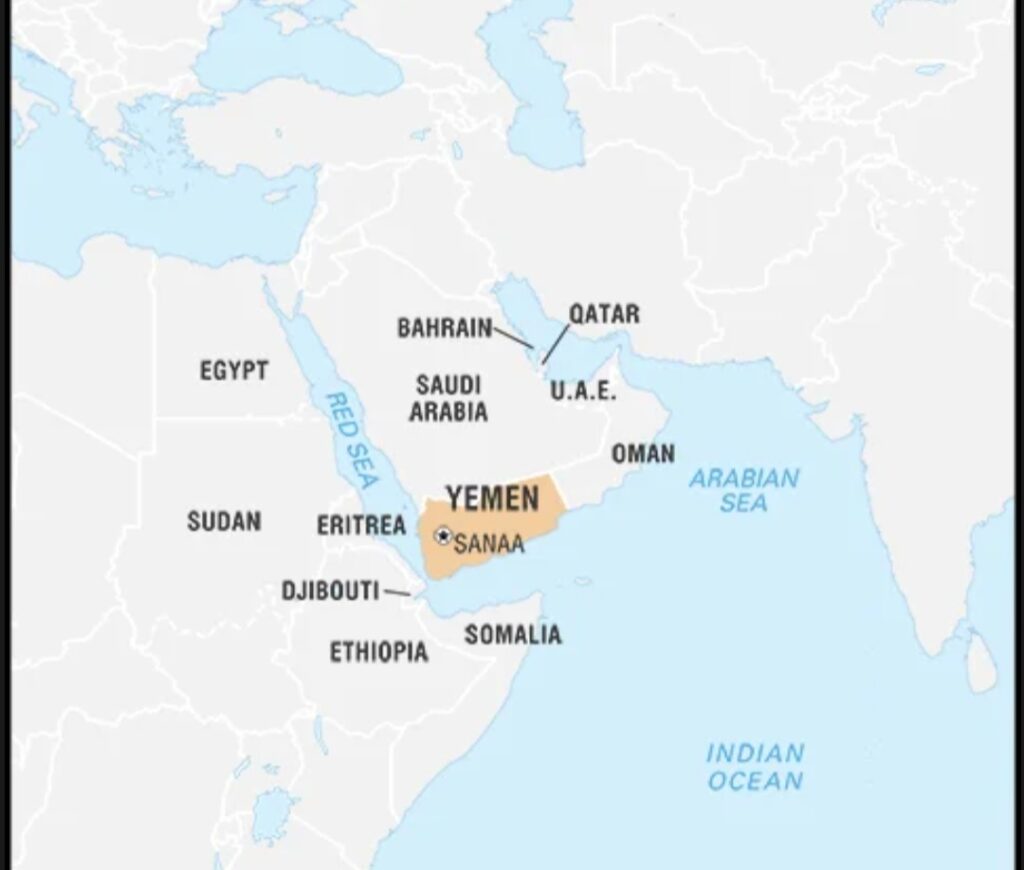By: Harshit Tokas, Research Analyst, GSDN

The involvement of Yemen’s Houthi movement in the Israel-Hamas conflict adds a new layer of complexity to an already volatile and multi-faceted situation in the Middle East. This article delves into the background of the Houthi movement, their role in the Yemen conflict, their recent actions against Israel, and their alignment with Iran’s “Axis of Resistance.” By examining these factors, we can better understand the implications of the Houthis’ involvement in the broader regional context.
The Houthi movement, also known as Ansar Allah (Supporters of God), emerged in Yemen in the 1990s, driven by dissatisfaction with the Yemeni government’s alignment with Saudi Arabia and the United States. The movement has positioned itself as an anti-imperialist and anti-foreign intervention force, advocating for economic development and self-determination for the Yemeni people.
The Houthi slogan, “God is Great, Death to America, Death to Israel, Curse on the Jews, Victory to Islam,” has drawn international attention. While some view this slogan as a literal threat, the Houthis claim it symbolizes their opposition to foreign interference by these countries. The movement is rooted in Zaydism, a Shiite sect that represents about 25% of Yemen’s population, with the majority being Sunni.
The conflict in Yemen began in 2014 when the Houthi rebels, backed by elements of the Yemeni military loyal to former President Ali Abdullah Saleh, seized control of Yemen’s capital, Sanaa. This action forced the internationally recognized government of President Abdrabbuh Mansur Hadi into exile and escalated the conflict. In response, a Saudi-led coalition intervened in March 2015 to restore Hadi to power and prevent Iranian influence from spreading in the region.
While the Houthi movement does not represent the officially recognized government of Yemen, it controls a significant portion of the country. This situation goes against Western efforts to contain the conflict within Yemen’s borders and prevent its spread to other parts of the Middle East.
The Houthi movement is closely aligned with Iran’s “Axis of Resistance,” an informal military coalition centered on anti-Western and anti-Israel sentiments. This alliance includes other militant groups like Lebanon-based Hezbollah, Palestinian militant groups such as Hamas, the Syrian government, and various Iraqi militant groups.
The Houthi movement’s alignment with the “Axis of Resistance” indicates its shared goals and strategic cooperation with these groups. In 2021, the Houthi leaders suggested a link with Hamas when they proposed swapping Saudi prisoners they held for the release of Palestinian prisoners. This move demonstrated their willingness to work in concert with other members of the “Axis of Resistance.”
The Houthi movement’s recent missile and drone attacks on Israel have brought the Israel-Hamas conflict to a new geographic and geopolitical context. While not the officially recognized government of Yemen, the Houthis have effectively declared their involvement in the Israel-Hamas conflict by targeting Israel with these attacks.
On several occasions, the Houthis have claimed responsibility for missile and drone attacks on Israel, signaling their intent to participate in the broader struggle against Israel. In the eyes of the Houthi military spokesperson, Yahya Saree, Israel is responsible for regional conflicts, and they have pledged to continue their involvement until Israeli aggression ceases.
The Houthi movement’s involvement in the Israel-Hamas conflict carries significant implications for regional stability and security. Here are some key points to consider:
(a) Regional Escalation: The Middle East is already a volatile region with numerous ongoing conflicts and geopolitical tensions. The Houthi attacks on Israel add another layer of complexity. While these attacks may, for now, be more about messaging than a military threat, there is a risk that an all-out engagement with multiple rockets launches from various directions could overwhelm Israeli air defenses. Such a scenario could lead to regional escalation.
(b) Broader Regional Conflict: The alignment of the Houthis with Iran’s “Axis of Resistance” raises the risk of a broader regional conflict. If Israel perceives a significant and sustained threat from the Houthis, it might respond in a way that escalates the situation. Israel has a history of preemptive military action when it believes it faces an existential threat. Moreover, if Hezbollah and Hamas coordinate their actions with the Houthis, the potential for a synchronized attack on Israel increases, which could lead to a wider regional conflict.
(c) Diplomatic Efforts: Diplomatic efforts to end the Yemen conflict and address broader regional tensions are crucial in preventing a wider war. The United States, as a key player in the region, will play a pivotal role in shaping the path toward peace and stability. Achieving lasting peace in a region with numerous competing interests and conflicts will undoubtedly be a formidable challenge.
The Houthi movement’s involvement in the Israel-Hamas conflict extends the reach of this already complex and interconnected regional conflict. The alignment of the Houthis with Iran’s “Axis of Resistance” underscores the broader regional implications of their actions. Diplomacy, prevention of regional escalation, and addressing the root causes of conflicts are essential steps in achieving lasting peace and stability in the Middle East.
The situation highlights the fragility of the region and the need for diplomatic initiatives to reduce tensions and prevent a broader regional conflict. International efforts must focus on de-escalation and fostering dialogue among key stakeholders to ensure the long-term security and stability of the Middle East. The recent Houthi attacks on Israel serve as a stark reminder of the intricate and volatile nature of the region and the urgency of finding diplomatic solutions to regional conflicts.

